#Placopsis
Photo

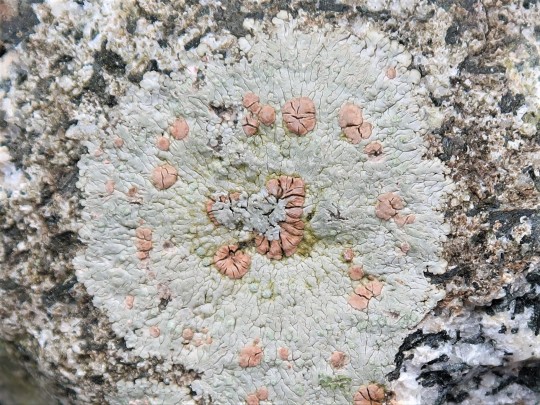
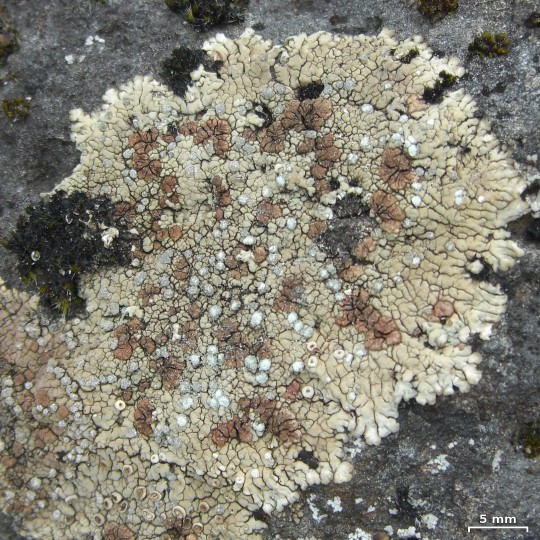

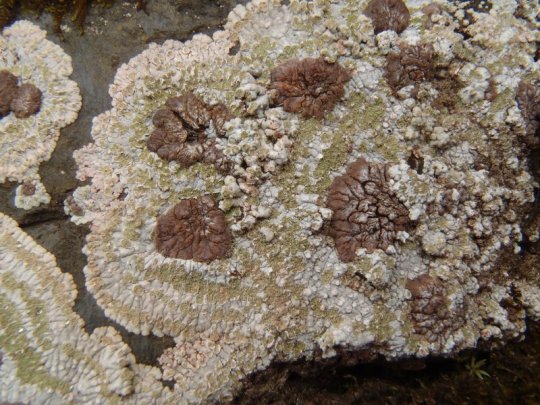
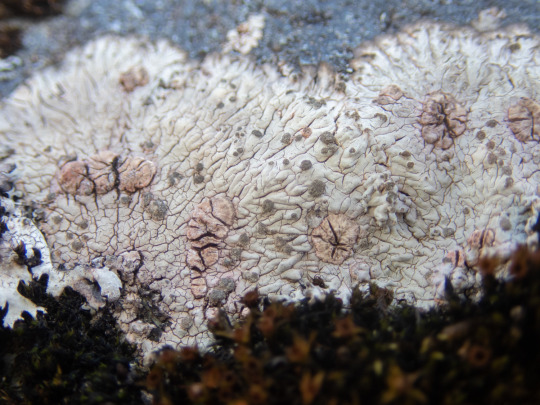
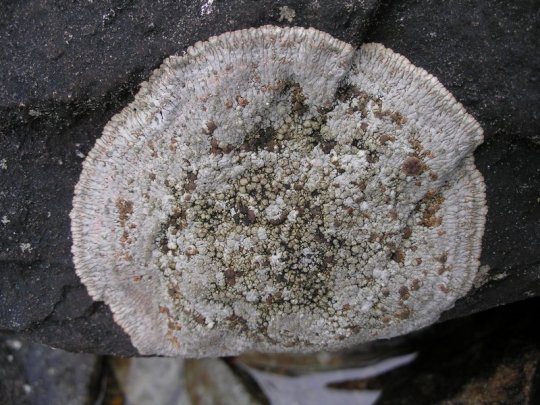

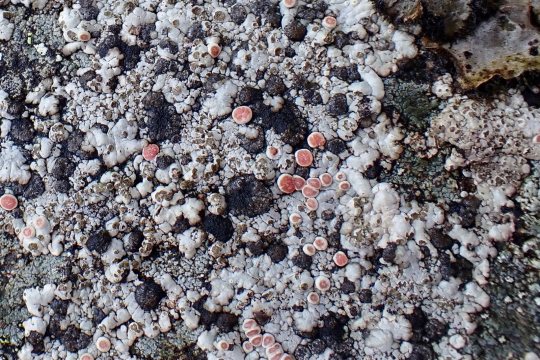
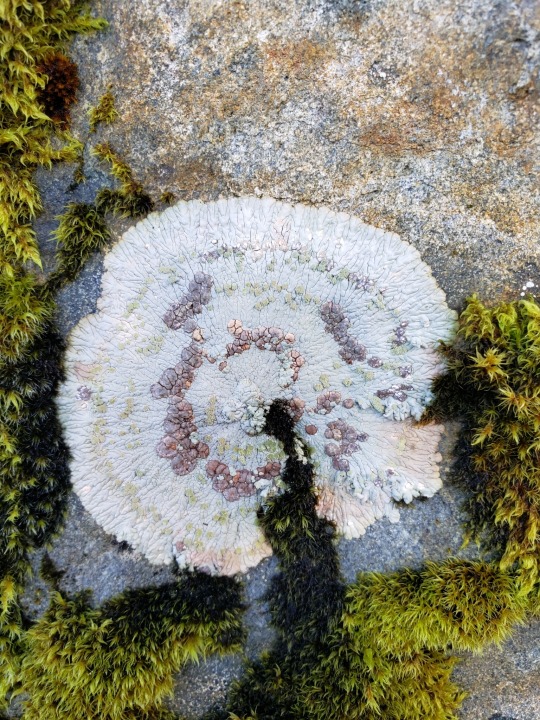
Placopsis lambii
So like, generally I agree that it’s not polite to stare. But like, P. lambii has A LOT going on, and it takes a good minute to take it all in. Like you might look at it and wonder, why does it have a weird thing that looks like a butthole? What are those gray spots? Or green spots? Or pink spots? Why is it sometimes really round and sometimes really blobby? All great questions, all of which I will do my best to answer. This crustose lichen has a radiating, placodioid thallus (rosette shaped, tile-like toward the center, lobe-like toward the outside). It is grey, cream, or tan, often with a pink or green tinge. The gray or green cracks or pustules you can see are soralia, which produce vegetative propagules in the form of soredia. The weird butthole-shaped, brownish-pinkish blob near the thallus center is a large cephalodia--a section of the thallus containing a secondary, cyanobacterial photobiont in an otherwise algal lichen. P. lambii doesn’t always have cephalodia--they are often only found in specimens that live in particularly moist environments. It also only occasionally produces apothecia, which have a yellow or bubble-gum pink disc and a prominent margin. P. lambii grows on siliceous rock in cold, damp areas near water. It has a scattered and rare distribution in Europe, Africa, South America, Asia, and New Zealand. This fella is easily confused with P. gelida, but they are genetically and chemically distinct. Both can be incredibly variable, so good luck IDing them in the field! At least you will know you are looking at a Placopsis, right? Because no other lichen is quite this same level of odd.
images: source | source | source
info: source | source | source | source
#trypophobia#trypo#lichen#lichens#lichenology#lichenologist#lichenized fungus#fungus#fungi#mycology#ecology#biology#botany#bryology#systematics#taxonomy#life science#environmental science#natural science#nature#naturalist#beautiful nature#weird nature#the natural world#Placopsis lambii#Placopsis#I'm lichen it#lichen a day#daily lichen post#lichen subscribe
98 notes
·
View notes
Video
Natural Psychedelia by Steve Reekie
Via Flickr:
On a walk up the hill behind my house yesterday, I found these rocks with the most amazing growths of lichen and what I assume are companion fungi. Placopsis gelida ... (bullseye lichen) is a genus of lichenized fungi in the family Agyriaceae.
#New Zealand#Wild#New Zealand Nature#New Zealand Wild#New Zealand Nature Photography#Steve Reekie#mycology#lichen#lichens#fungus#Ascocoryne sarcoides#Placopsis#species#Wilderness#photography#New Zealand Geographic#National Geographic#New Zealand fungi#New Zealand fungus#Wild New Zealand
5 notes
·
View notes
Text
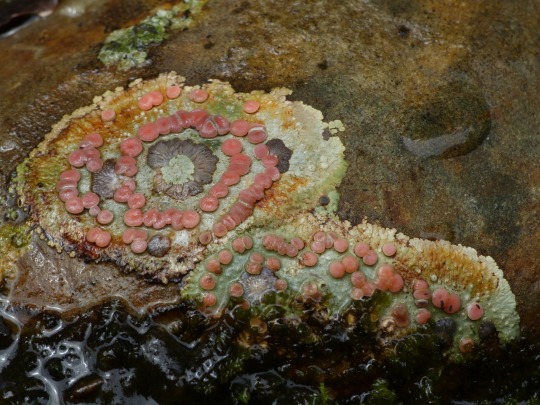

Bullseye Lichen
#!!!!!!#guh!!!!#so cool#bullseye lichen#water#nature#photography#placopsis gelida#pink#purple#lichen#fungus#fungi#concentric#patterns in nature
327 notes
·
View notes
Text

Bullseye lichen (Placopsis gelida) Iceland by Atli Arnarson
13 notes
·
View notes
Text
Lichens in New Zealand - Observation of the Week, 11/24/18

This group of Placopsis lichens, seen in New Zealand by linda_johnson, is our Observation of the Week!
Since she joined the Royal Forest & Bird Protection Society of New Zealand, Inc. (Forest & Bird for short) a dozen years ago, Linda Johnson says “My interest and knowledge [in nature] has grown a lot.” She’s a coordinator for the Kiwi Conservation Club, a junior section of Forest & Bird, and “preparing nature-based activities for the KCC children has been a significant contributor to my increased knowledge about nature.” She also take part in pest control initiatives and restoration work.
Linda recently spent five days and four nights hiking The Old Ghost Road (OGR), an abandoned mining road in New Zealand’s Kahurangi National Park, and recounts
Whenever I'm out hiking I'm taking notice of what is around me and regularly stopping to get a better look around without falling over. The first day of the OGR was in beautiful beech forest and there was an abundance of bird life, especially NZ robins. On the second day we got up above the tree line and I was seeing plants I don't usually have an opportunity to see. The day was sunny and a section of the track had a rocky bank with grass and other low growing vegetation on it. There were some big boulders not covered by vegetation. The colours and shapes of the lichen on the rocks were eye catching so I stopped to take a photo.
The lichens she photographed are in the genus Placopsis, which are often referred to as “bullseye lichen” due to the their appearance. A crustose lichen, they grow tightly to their substrate (in this case a rock) and their more conspicuous structures are often grouped toward the center, with the thallus extending outward. Lichens can reproduce both sexually and asexually, and it looks like sexual reproductive structures called apothecia are the dark red dots fringed by lighter tissue. I’m not sure what the striking structures in the middle are - if you know, write in the comments!

Linda (above, on the OGR), mainly uses iNat for ID help and to make sure there are records for particular places. “For instance, I uploaded photos from my visits to the Chatham Islands (800km east of New Zealand), and subsequently was told I was the first person to submit data from there,” she says. “I actually started taking more photos on the OGR with iNaturalist in mind after taking the lichen photo.”
- by Tony Iwane
- Lichens have long been thought to be a symbiosis between a fungus and algae or cyanobactera, but recently a third partner has been found.
- Do lichens age? A Harvard mycologist has been studying lichens in a cemetery in an attempt to answer that question.
7 notes
·
View notes
Video
Lichens as Biological Fertilizers by Field Museum
Via Flickr:
Lichens have many different roles in ecosystems. One of their most important is to act as biological fertilizers. Nitrogen is one of the essential nutrients, forming part of organic and macromolecules such as amino acids, proteins, nucleic acids (DNA, RNA), and chlorophyll. Nitrogen occurs in the nitrogen cycle in four forms, as free nitrogen (N2) in the atmosphere, as ammonia (NH3), as nitrite (NO2–), and as nitrate (NO3–). Whereas plants are able to incorporate nitrate into their metabolism through a process called assimilation, the other three forms can only be used by different kinds of bacteria. Hence, bacteria are essential to maintain the nitrogen cycle and making plant, animal, and fungal life possible. The most important source of nitrogen is the free nitrogen that makes up 78% of the atmosphere. However, only certain bacteria are capable of using this form of nitrogen and incorporating it into the nitrogen cycle, through the process of fixation. Many of these bacteria form symbioses with plant roots, for example in the bean family (Fabaceae). Another large group are cyanobacteria, and many of these enter symbioses with fungi to form lichens. Cyanobacterial lichens are especially abundant in nutrient-poor environments and hence, with their substantial biomass, act as biological fertilizers, without the negative side effects of industrial nitrates. Some of these lichens are depicted here (from left to right, top to bottom): Sticta, Placopsis (a green algal lichen with additional cyanobacteria in so-called cephalodia), Cora, Leptogium, Lobariella, Erioderma. (c) The Field Museum, Robert Luecking
#Field Museum#Science#Natural History#Chicago#Lichens#Fertilizers#lichen#forest#nature#biology#botany#lichenology
114 notes
·
View notes
Photo
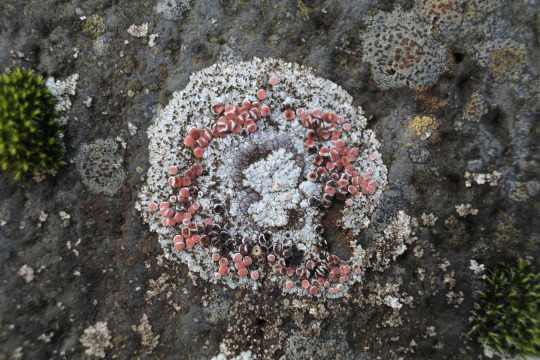
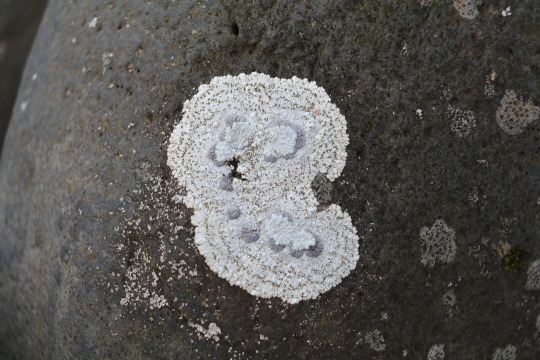
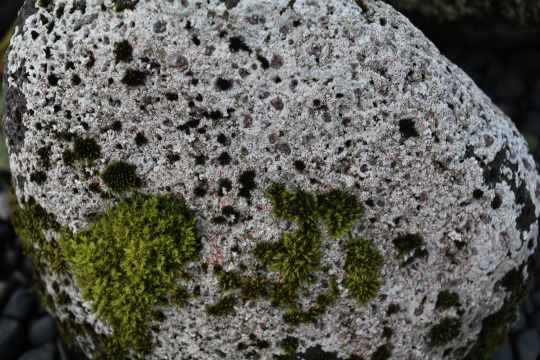

Placopsis species in Vík í Mýrdal, Iceland.
Look at those bubblegum pink apothcia!
#lichen#lichens#lichenology#lichenologist#lichenized fungus#lichenized fungi#fungus#fungi#mycology#ecology#biology#nature photography#photography
123 notes
·
View notes
Photo


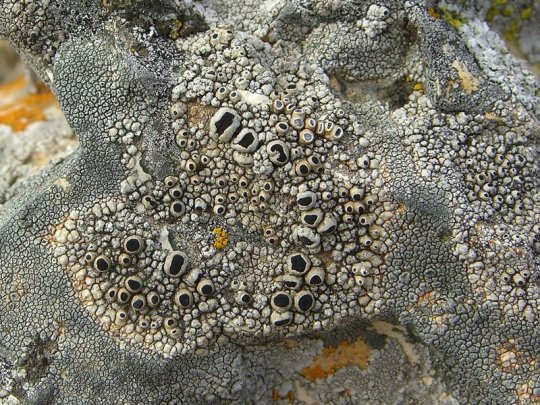
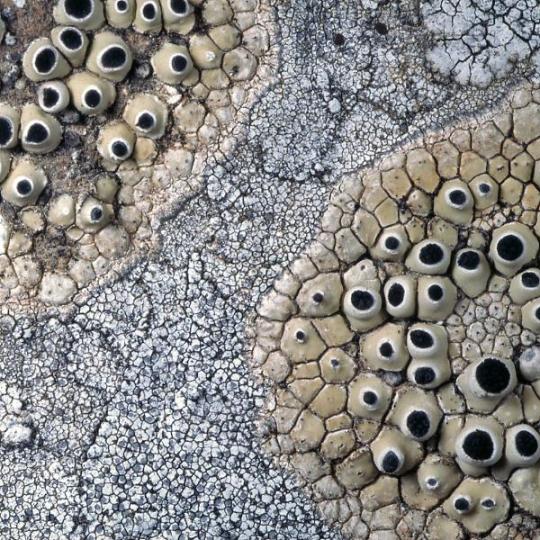



Thelomma mammosum
Rock nipple, doll’s eyes
Yesterday was the first day I missed a post since starting this project, and I would like to apologize. Valentines day--they day when I should have laid out the extent of my love for lichens. And I failed. So today, 2 lichen posts!
The first of my great loves I would like to share is T. mammosum! A while ago I posited that Placopsis gelida looked like a boob. But this is canonically the boob lichen! Who knew? This areolate crustose lichen forms strongly convex verrucas, and when fertile these are filled with black mazaedium in the centeral apothecial disc.The surface is olive-gray and shiny, almost leathery in appearance. It usually grows on rock near coasts in Europe and North America. It’s a really cool looking lichen and I enjoy it very much (even though I don’t think it looks that much like a boob sorry).
Happy day after Valentine’s day!
source | source
#lichen#lichens#lichenology#lichenologist#lichenthrope#biology#botany#mycology#fungus#fungi#lichenized fungus#bryology#nature#natural science#sicentist#citizen science#go outside#take a hike#photograph your local lichen#ecology#ecologist#not plants#beautiful nature#weird nature#daily lichen#daily lichen post#I'm lichen it
58 notes
·
View notes
Photo


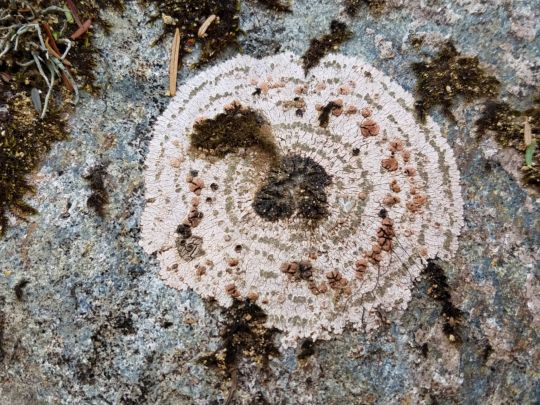
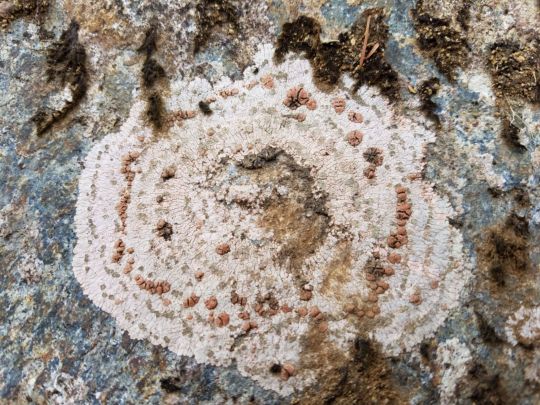


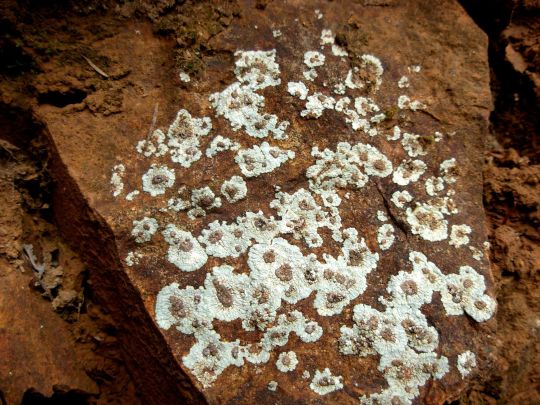

Placopsis gelida
Bull’s-eye lichen
I told my partner that I thought this lichen looked like a boob and he gave me a weird look. Just thought I’d share. Anyway, this is P. gelida! It’s a crustose lichen that forms fissured, placodioid rosettes. It can also appear more areolate depending on the growth stage it is in. It is typically pale beige in color with conspicuous darker peach to brown cephalodia and greenish-gray soredia spotted over the surface, often concetrated toward the center of the rosette. Apothecia are rare, and form immersed, pruinose discs. It grows on rocks and pebbles in alpine-arctic habitats. Probably. Take everything said above with a probably. Apparently P. gelida is really hard to distinguish from P. lambii, and so a lot of sources of information are unreliable, and more research is needed to delimitate the exact range, growth habits, and variations of each. They may even need to be synonomized. Both are good and pure and yeah, kinda look like boobs if you squint your eyes and use your imagination. Don’t judge me.
Follow for more daily lichen posts!
source | source | source | source |source
#lichen#lichens#lichenology#lichenologist#lichenized fungus#I'm lichen it#lovin lichen#lichen life#lichenthrope#mycology#fungus#fungi#daily lichen post#bryology#botany#biology#ecology#nature#nature is beautiful#we'll see if tumblr blocks me for this#goblin core#nature core#natural science#go oustide
27 notes
·
View notes